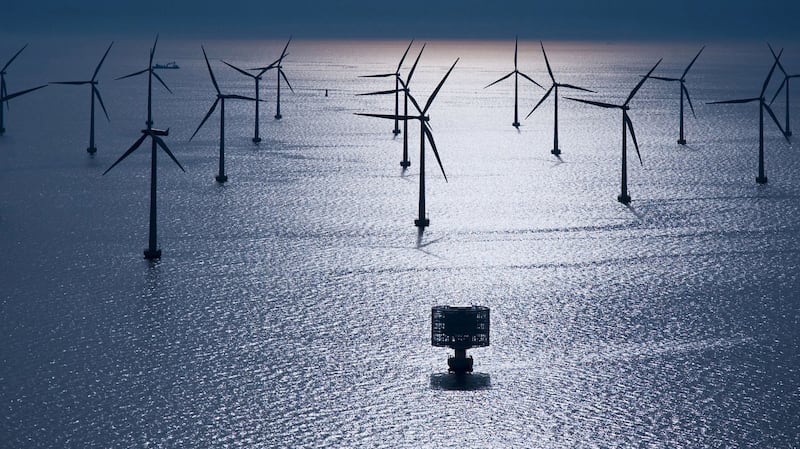In a bold and ambitious seabed auction, the Scottish government has delivered Scotland as the premier global location for floating offshore wind. Bar none.
This has been achieved despite Scotland having notably poor grid capacity, resulting in limited scope for the local uptake of the huge volumes of power to be generated from these offshore giants.
Rather than wait to upgrade the grid infrastructure, the Scots have taken the view that the excess energy will find a home,through the utilisation of electricity from offshore wind to facilitate the production of green hydrogen and ammonia.
These are arguably the fuels of the future. Scotland has seized the momentum created by market demand for hydrogen in mainland Europe, notably in Germany, to kick-start the development a new energy export economy.
The results of the recent seabed auction, known as ScotWind, will see a £700 million (€840 million) upfront payment to the Scottish Government, from the consortia of oil and gas supermajors, utilities and investment firms. Seventeen projects were selected from more than 70 bids, and the winners have been offered option agreements, which reserve the rights to a total of 7,000 sq km of seabed.
The projects have a combined generating capacity of 25GW – enough wind farms to power the equivalent of 23 million UK homes a year. This is well above the anticipated auction outcome of 10GW expected to contribute to the decarbonisation of Scotland’s economy.
However, this isn’t the only standout fact. Sixty per cent of the projects will utilise floating offshore wind technology. These wind turbines will sit on floating foundations anchored to the sea floor in water depths of more than 80 metres, opening offshore areas with high wind capacity to new development. In short, floating wind is revolutionising the offshore wind sector in Scotland.
The lesson from Scotland is that courageous leadership and policy-making can bring about the transformation necessary to arrest climate change
Across the Irish Sea, advocates of the development of floating offshore wind in Ireland, such as joint venture partners Simply Blue Group and Shell New Energies, recognise the enormous potential of Ireland’s maritime area, which is seven times its landmass, combined with one of the best offshore wind resources in the world.
Developers promote the opportunity for floating offshore wind to deliver positive affects for climate change, coastal economies, job creation, and biodiversity in Ireland.
Playing catch-up
Meanwhile, the Irish Government has been busy playing catch-up. After decades of neglect of the marine planning system, the new Marine Area Plan law was enacted in December. This is a milestone for the regulation of all offshore activities. However, it is only the tip of the iceberg with regards to the policy changes yet to be delivered. These include the establishment of the Maritime Area Regulatory Agency , the introduction of legislation for designation of Marine Protected Areas, the design of a process for issuing seabed leases akin to ScotWind, and the delivery of the first offshore renewable energy support schemes.
Investment in demonstration projects, such as Hywind, the world’s first floating offshore wind farm off Aberdeenshire, put Scotland on the map when it commenced operations in 2017. Fast forward five years and Scotland is gearing up to deploy 15GW of floating wind technology.
By comparison, Ireland has a milestone target in the Climate Action Plan of 5GW of offshore wind by 2030. The consensus is that this is challenging, and it might not be met. Taking a leaf out of Scotland’s book, what would setting a higher target look like? This would be a potential game-changer and would require a shift in thinking about the importance of grid capacity.
The current approach linking offshore wind to existing grid and proximity to demand centres puts an emphasis on Dublin and the east coast.
Meanwhile, developers of floating offshore wind projects in the west of Ireland await plans to be put in place by Eirgrid to enable connection to the existing grid in Moneypoint. A more ambitious target would also require Irish policymakers to prioritise the development of a policy to support green hydrogen production and to start thinking in terms of the lead-in to 2030 and beyond.

It is impossible to say if any of the target of 5GW will come from floating offshore wind, despite the fact that floating offshore wind can provide at least 30GW of energy from the west coast alone.
Furthermore, floating wind offers the greatest economic development opportunity that this country has seen since Ardnacrusha was enabled to power a nascent State.
It makes sense to initiate projects and to kick off the supply chain as early as possible. However, the official line is Ireland will seek to develop floating wind post-2030, when the technology is mature. Following the results of ScotWind, the evidence of both the industry and technology readiness to deliver floating wind projects means it is simply impossible to maintain this position.
The lesson from Scotland is that courageous leadership and policy-making can bring about the transformation necessary to arrest climate change, while paving the way for a maritime economy where generations of coastal communities can reap the benefits.
In Ireland, we need to accelerate momentum to pull this same future towards us. This involves a root-and-branch questioning of the prevailing logic, and engagement with enterprise development to provide a plan. We now have a template to follow. If we have the will, Scotland has shown us the way.
Val Cummins is operations and projects director for Simply Blue Group in Ireland












